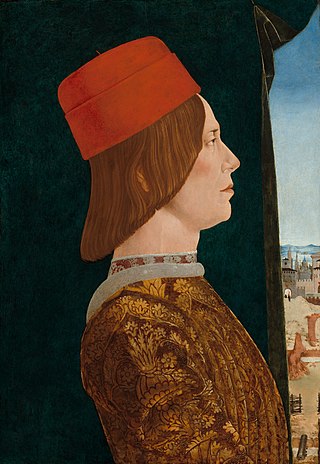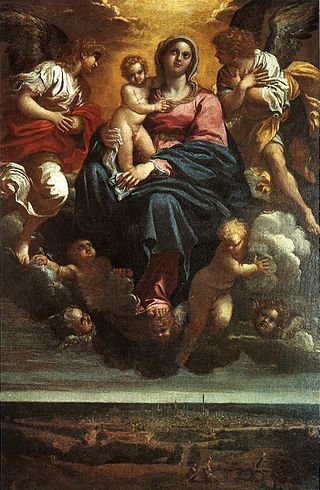Description
The painting is a large canvas, executed by Costa together with other two works on the chapel's walls, the Triumph of Fame and the Triumph of Death. It features, above a sumptuous Renaissance architecture, a marble altar with a rich frieze; at the top of is a throne on which the Madonna and Child sit. At the sides, kneeling, are the two donor husband and wife, Giovanni II Bentivoglio and Ginevra Sforza. In the foreground, at the feet of the throne, are their eleven children. On the left are the daughters (from left, Camilla, Bianca, Francesca, Violante - future spouse of Pandolfo IV Malatesta, Laura, Isotta and Eleonora); on the right the four children (Ermes, Alessandro, Anton Galeazzo and the elder one, Annibale).

Francesco del Cossa was an Italian Renaissance painter of the School of Ferrara, who after 1470 worked in Bologna. Cossa is best known for his frescoes, especially his collaboration with Cosimo Tura on a cycle of the months in the Palazzo Schifanoia of the Este family, rulers of Ferrara. Otherwise, his paintings are mostly of religious subjects, with some portraits and drawings attributed to him. He also designed stained glass.

The Bentivoglio family was an Italian noble family that became the de facto rulers of Bologna and responsible for giving the city its political autonomy during the Renaissance, although their rule did not survive a century.

Lorenzo Costa was an Italian painter of the Renaissance.

Amico Aspertini, also called Amerigo Aspertini, was an Italian Renaissance painter and sculptor whose complex, eccentric, and eclectic style anticipates Mannerism. He is considered one of the leading exponents of the Bolognese School of painting.

The Basilica of San Petronio is a minor basilica and church of the Archdiocese of Bologna located in Bologna, Emilia Romagna, northern Italy. It dominates Piazza Maggiore. The basilica is dedicated to the patron saint of the city, Saint Petronius, who was the bishop of Bologna in the fifth century. Construction began in 1390 and its main facade has remained unfinished since. The building was transferred from the city to the diocese in 1929; the basilica was finally consecrated in 1954. It has been the seat of the relics of Bologna's patron saint only since 2000; until then they were preserved in the Santo Stefano church of Bologna.

The Basilica of San Domenico is one of the major churches in Bologna, Italy. The remains of Saint Dominic, founder of the Order of Preachers (Dominicans), are buried inside the exquisite shrine Arca di San Domenico, made by Nicola Pisano and his workshop, Arnolfo di Cambio and with later additions by Niccolò dell'Arca and the young Michelangelo.

Gualtieri is a comune (municipality) in the Province of Reggio Emilia in the Italian region Emilia-Romagna, located about 70 kilometres (43 mi) northwest of Bologna and about 25 kilometres (16 mi) north of Reggio Emilia on the right bank of the Po River. Historically, it suffered numerous floods, the last occurring in 1951. It is a member of the I Borghi più belli d'Italia association.

Ercole de' Roberti, also known as Ercole Ferrarese or Ercole da Ferrara, was an Italian artist of the Early Renaissance and the School of Ferrara. He was profiled in Vasari's Le Vite delle più eccellenti pittori, scultori, ed architettori. The son of the doorkeeper at the Este castle, Ercole later held the position of court artist for the Este family in Ferrara. According to Vasari:
Ercole had an extraordinary love of wine, and his frequent drunkenness did much to shorten his life, which he had enjoyed without any accident up to the age of forty, when he was smitten one day by apoplexy, which made an end of him in a short time.

Italian Renaissance painting is the painting of the period beginning in the late 13th century and flourishing from the early 15th to late 16th centuries, occurring in the Italian Peninsula, which was at that time divided into many political states, some independent but others controlled by external powers. The painters of Renaissance Italy, although often attached to particular courts and with loyalties to particular towns, nonetheless wandered the length and breadth of Italy, often occupying a diplomatic status and disseminating artistic and philosophical ideas.

Palazzo Re Enzo is a palace located on Piazza del Nettuno, 1 in the historic center of Bologna, northern Italy. The palace takes its name from Enzio of Sardinia, Frederick II's son, who was prisoner here from 1249 until his death in 1272. The palace is presently used to sponsor cultural events and exhibitions.

Ginevra Sforza became the wife of Sante Bentivoglio and then of Giovanni II Bentivoglio, both de facto signori of Bologna. She had 18 children and served the Bentivoglio family by fulfilling the gendered role demanded of her by society.

Giovanni II Bentivoglio was an Italian nobleman who ruled as tyrant of Bologna from 1463 until 1506. He had no formal position, but held power as the city's "first citizen." The Bentivoglio family ruled over Bologna from 1443, and repeatedly attempted to consolidate their hold of the Signoria of the city.

The Madonna and Child Enthroned with Saints John the Baptist and Sebastian is a painting by the Italian Renaissance artist Pietro Perugino, executed in 1493 and housed in the Uffizi Gallery, Florence.

The Madonna in Glory with Saints is a painting by the Italian Renaissance painter Pietro Perugino, dating to c. 1500–1501. It is housed in the Pinacoteca Nazionale of Bologna, Italy.

San Giovanni in Monte is a 15th-century Roman Catholic church in Bologna, Italy.

The Oratory of Saints Cecilia and Valeriano is a religious site in central Bologna, found on Via Zamboni, contiguous to the portico of the church of San Giacomo Maggiore.

The Sanctuary of the Madonna del Baraccano is a Renaissance style, Roman Catholic church, located at Piazza del Baraccano 2 at the southern edge of the formerly walled central Bologna, region of Emilia-Romagna, Italy. The church was built at the site of city wall, where a Madonna image was painted, hence called Madonna of the Barricade. Presently much at the site is undergoing restoration after the May 2012 earthquake.
Filippo Beroaldo, sometimes called "the Elder" to distinguish him from his cousin Filippo Beroaldo the Younger, and also known as Philip or Philippus Beroaldus was an Italian humanist active as a professor at the University of Bologna.

Madonna and Child in Glory over the City of Bologna is a c.1593 oil on canvas painting by Annibale Carracci, also known as The Virgin and Child in the Clouds or the Madonna of Bologna. It is now in Christ Church Picture Gallery in Oxford.



















